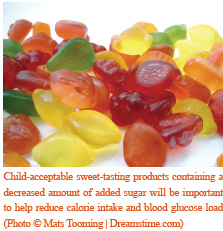Important opportunities exist for the development of new food products designed to help children achieve optimal growth and development

PARENTAL concern for their child's health is an important market driver, with a focus on immunity as a top health concern. The New Nutrition Business report concurs with this assessment and adds that all-natural ingredients and products that are "free-from" ingredients that are perceived as unhealthy are also important consumer issues. The second most important concern amongst parents is gut health, and with a growing awareness of the rise of overweight and obese children, parents are also becoming increasingly concerned about products containing "added sugars." Another important market area catching on with parents' desire to feed their children healthy foods is the growth of kids' organic snacks that has encouraged the proliferation of many small, family-owned companies providing wholesome organic foods aimed at children. Of course, it is not always about what the parent wants for their child; there is also the issue of what foods are acceptable to a child. According to a report from Leatherhead Food Research on children's food and drink in Europe, important triggers for children include flavours, texture, shapes, packaging, cartoon characters and play elements. A potential growth area for child-oriented food is the rise in interest in healthy, "on-the-go" snacks for children or other similar convenience foods, particularly those that are lower in sugar and fat, given the fact that one-third of kids five- to 13-years of age are overweight (greater than 85th percentile weight for age) or obese (greater than the 95th percentile weight for age).
Childhood Obesity Many factors contribute to this rise in childhood obesity, including poor eating habits and general inactivity. From a nutritional standpoint, more effort needs to be placed on eating healthier foods and avoiding eating oversized portions of fast foods that are high in fat and calories. Growing children have high energy needs and will gain body weight as they mature, but they need to be careful that they don't consume too many calories that can lead to inappropriate weight gain and obesity. Abnormal levels of serum cholesterol have been recently reported to occur in 14% of normal weight 12 to 19 year-old children, but in those classified as obese, those levels rise to 43 per cent. Satiety-inducing ingredients, such as protein - in particular whey protein; fibres such as inulin and oligofructose; oils such as Korean pine nut, palm and oat; and hydroxycitrate (HCA) may help to deliver a sense of fullness when used to fortify children's food and beverage products. However, the best approach to weight management and obesity will continue to be increased physical activity, accompanied with a healthier diet that includes a multitude of fruits, vegetables and whole grains.
Cognitive Function and Attention Another important area of parental concern is that their children's nutritional intake is optimising their cognitive function and reducing the risk of developing attention disorders, such as Attention Deficit Hyperactivity Disorder (ADHD).The exact cause of ADHD is unknown, but this condition can have significant effects on behaviour and school academic performance, and that it is best to focus on supporting a child's brain so they can reach their maximum potential. Other important disorders of concern to parents of school age children include autistic behaviours, which affect one in 150 children, and are characterised by poor social interactions, communication skills, repetitive and ritual behaviours and aversion to noise. The role of nutrition in the pathogenesis of ADHD, autism and learning disabilities is unknown but there continues to be interest in this possibility.

A growing
KD VIII N7 Glowing PARENTAL concern for their child's health is an important market driver, with a focus on immunity as a top health concern. The New Nutrition Business report concurs with this assessment and adds that all-natural ingredients and products that are "free-from" ingredients that are perceived as unhealthy are also important consumer issues. The second most important concern amongst parents is gut health, and with a growing awareness of the rise of overweight and obese children, parents are also becoming increasingly concerned about products containing "added sugars." Another important market area catching on with parents' desire to feed their children healthy foods is the growth of kids' organic snacks that has encouraged the proliferation of many small, family-owned companies providing wholesome organic foods aimed at children. Of course, it is not always about what the parent wants for their child; there is also the issue of what foods are acceptable to a child. According to a report from Leatherhead Food Research on children's food and drink in Europe, important triggers for children include flavours, texture, shapes, packaging, cartoon characters and play elements. A potential growth area for child-oriented food is the rise in interest in healthy, "on-the-go" snacks for children or other similar convenience foods, particularly those that are lower in sugar and fat, given the fact that one-third of kids five- to 13-years of age are overweight (greater than 85th percentile weight for age) or obese (greater than the 95th percentile weight for age). Childhood Obesity Many factors contribute to this rise in childhood obesity, including poor eating habits and general inactivity. From a nutritional standpoint, more effort needs to be placed on eating healthier foods and avoiding eating oversized portions of fast foods that are high in fat and calories. Growing children have high energy needs and will gain body weight as they mature, but they need to be careful that they don't consume too many calories that can lead to inappropriate weight gain and obesity. Abnormal levels of serum cholesterol have been recently reported to occur in 14% of normal weight 12 to 19 year-old children, but in those classified as obese, those levels rise to 43 per cent. Satiety-inducing ingredients, such as protein - in particular whey protein; fibres such as inulin and oligofructose; oils such as Korean pine nut, palm and oat; and hydroxycitrate (HCA) may help to deliver a sense of fullness when used to fortify children's food and beverage products. However, the best approach to weight management and obesity will continue to be increased physical activity, accompanied with a healthier diet that includes a multitude of fruits, vegetables and whole grains. Cognitive Function and Attention Another important area of parental concern is that their children's nutritional intake is optimising their cognitive function and reducing the risk of developing attention disorders, such as Attention Deficit Hyperactivity Disorder (ADHD).The exact cause of ADHD is unknown, but this condition can have significant effects on behaviour and school academic performance, and that it is best to focus on supporting a child's brain so they can reach their maximum potential. Other important disorders of concern to parents of school age children include autistic behaviours, which affect one in 150 children, and are characterised by poor social interactions, communication skills, repetitive and ritual behaviours and aversion to noise. The role of nutrition in the pathogenesis of ADHD, autism and learning disabilities is unknown but there continues to be interest in this possibility.
PARENTAL concern for their child's health is an important market driver, with a focus on immunity as a top health concern. The New Nutrition Business report concurs with this assessment and adds that all-natural ingredients and products that are "free-from" ingredients that are perceived as unhealthy are also important consumer issues. The second most important concern amongst parents is gut health, and with a growing awareness of the rise of overweight and obese children, parents are also becoming increasingly concerned about products containing "added sugars." Another important market area catching on with parents' desire to feed their children healthy foods is the growth of kids' organic snacks that has encouraged the proliferation of many small, family-owned companies providing wholesome organic foods aimed at children. Of course, it is not always about what the parent wants for their child; there is also the issue of what foods are acceptable to a child. According to a report from Leatherhead Food Research on children's food and drink in Europe, important triggers for children include flavours, texture, shapes, packaging, cartoon characters and play elements. A potential growth area for child-oriented food is the rise in interest in healthy, "on-the-go" snacks for children or other similar convenience foods, particularly those that are lower in sugar and fat, given the fact that one-third of kids five- to 13-years of age are overweight (greater than 85th percentile weight for age) or obese (greater than the 95th percentile weight for age). Childhood Obesity Many factors contribute to this rise in childhood obesity, including poor eating habits and general inactivity. From a nutritional standpoint, more effort needs to be placed on eating healthier foods and avoiding eating oversized portions of fast foods that are high in fat and calories. Growing children have high energy needs and will gain body weight as they mature, but they need to be careful that they don't consume too many calories that can lead to inappropriate weight gain and obesity. Abnormal levels of serum cholesterol have been recently reported to occur in 14% of normal weight 12 to 19 year-old children, but in those classified as obese, those levels rise to 43 per cent. Satiety-inducing ingredients, such as protein - in particular whey protein; fibres such as inulin and oligofructose; oils such as Korean pine nut, palm and oat; and hydroxycitrate (HCA) may help to deliver a sense of fullness when used to fortify children's food and beverage products. However, the best approach to weight management and obesity will continue to be increased physical activity, accompanied with a healthier diet that includes a multitude of fruits, vegetables and whole grains. Cognitive Function and Attention Another important area of parental concern is that their children's nutritional intake is optimising their cognitive function and reducing the risk of developing attention disorders, such as Attention Deficit Hyperactivity Disorder (ADHD).The exact cause of ADHD is unknown, but this condition can have significant effects on behaviour and school academic performance, and that it is best to focus on supporting a child's brain so they can reach their maximum potential. Other important disorders of concern to parents of school age children include autistic behaviours, which affect one in 150 children, and are characterised by poor social interactions, communication skills, repetitive and ritual behaviours and aversion to noise. The role of nutrition in the pathogenesis of ADHD, autism and learning disabilities is unknown but there continues to be interest in this possibility.  A growingKD VIII N7 Glowing
A growingKD VIII N7 Glowing
 iConnectHub
iConnectHub
 Login/Register
Login/Register Supplier Login
Supplier Login


























